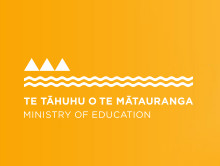Te Pō Whakangahau (wh. 12–17)
nā Te Rau-o-te-Rangi Winterburn
Hei whakarāpopoto
He whakaari tēnei. He kōrero mō te haerenga o ngā kiripuaki, a Hākui rāua ko Ritchie, ki te whare pikitia i te tāone. Ko Maire te mātāmua o te whānau, māna e tiaki ōna tungāne. Engari, he whakaaro kē tā Maire rāua ko Dan kia karangahia he pō whakangahau ki tō rātou kāinga i te wā e ngaro ana ō rāua mātua. Engari rā, i te hokinga mai o ngā mātua ka kōhete i ngā tamariki.
Summary
This is a play. It is a story about Hākui and Ritchie going to the movies for the night. Maire, the eldest child, is left to care for her brothers. Maire and Dan decide to organise a party while their parents are away. When their parents return they are told off.
| Te momo reo tuhi Language style |
|
|---|---|
| Ētahi āhuatanga o tēnei momo reo tuhi Features of this language style |
|
I te Ākonga e Pānui ana i te Pukapuka
During Reading
1. Mā ngā ākonga te whakaari e pānui, kātahi ka whakautua ēnei pātai:
- Ko wai ngā kiripuaki?
- Ki ōu whakaaro, kei hea tēnei whānau e noho ana?
- Ki ōu whakaaro, nā wai te hē?
- Ki ōu whakaaro he aha ngā kare ā-roto a Tāwhai i te wā o te whakangahau?
Students read the play carefully, then answer the following questions:
- Who are the characters?
- Where do you think the family live?
- Who do you think did the wrong thing?
- How do you think Tāwhai felt when they had a party?
2. Ka noho takirima ngā ākonga kia pānui ā-waha i te whakaari. Ka matapae ngā ākonga takiono ka aha te ia o te kōrero whai muri i te whakapai i te whare.
In groups of five, students read aloud and act out the play. They then predict what the next scene would be and what the conversation would include following on from the children cleaning up.
3. Tonoa ki ngā ākonga kia tirohia te pikitia kei te whārangi 15. Tonoa rātou kia tuhi i tētahi kupumahi, tētahi kupu āhua, me tētahi kupu ingoa kua toko ake i ō rātou whakaaro i te tirohanga tuatahi ki te whakaahua. Mā ēnei kupu ka titoa e rātou tētahi rerenga kōrero kia tekau-mā-rima, iti ake rānei, ngā kupu. Mā te ākonga tāna ake tuhinga e pānui ki tētahi atu, me te whakamārama atu te take i kōwhiria ai e ia aua kupu.
Ask students to look at the picture on page 15. Direct them to write one verb, one adjective, and one noun from their immediate reaction after seeing the image. Using these words they then write a sentence relating to the picture of no more than fifteen words. Get the students to read their sentence to another person and explain why they selected their words.



